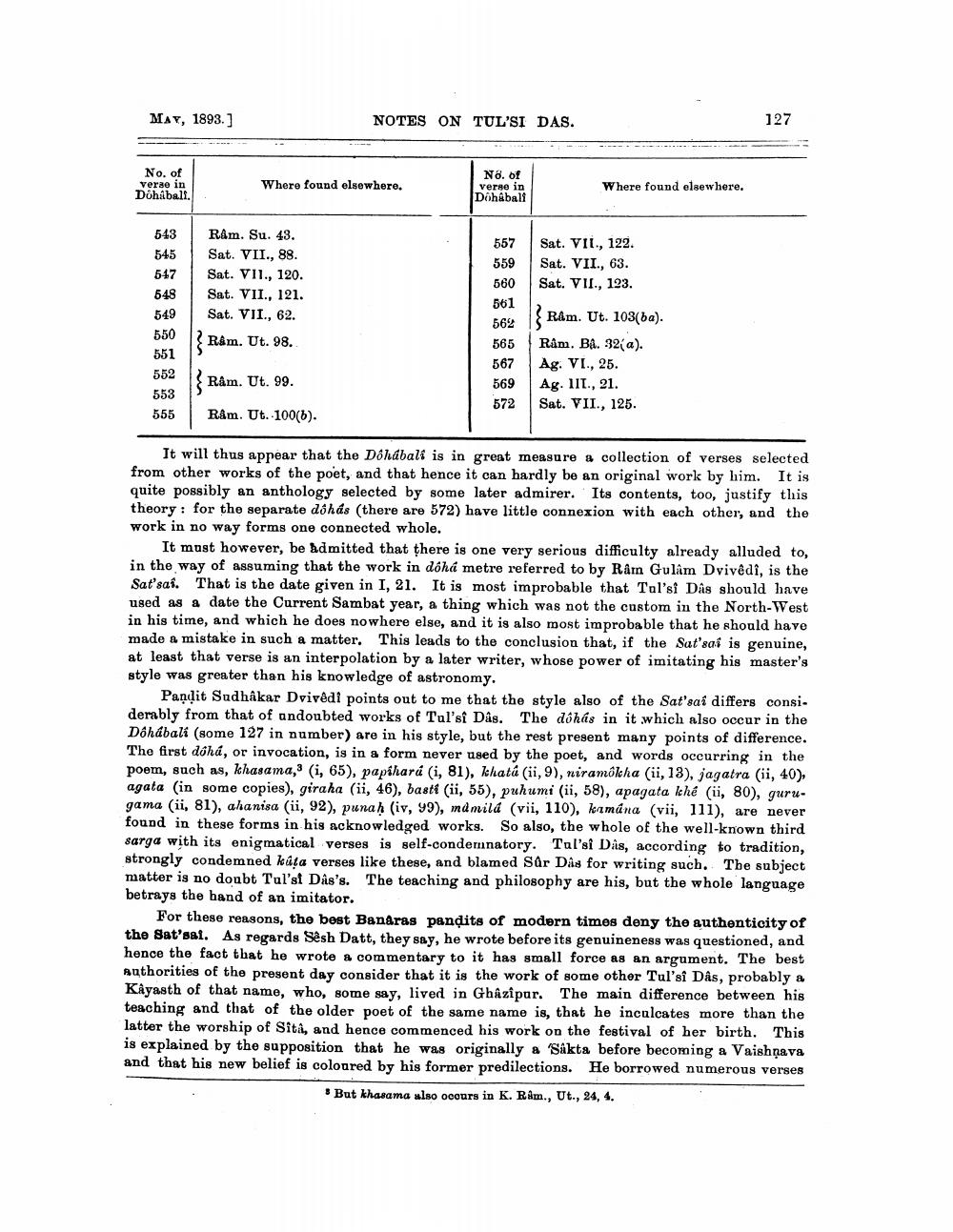________________
MAY, 1893. ]
NOTES ON TUL'SI DAS.
127
No. of verae in Dóháball.
Where found elsewhere.
No. of verne in Dôhåball
Where found elsewhere.
543 545
557
Sat. VII., 122. Sat. VII., 63. Sat. VII., 123.
547
Rám. Su. 43. Sat. VII., 88. Sat. VII., 120. Sat. VII., 121. Sat. VII., 62. Rám. Ut. 98.
548
559 560 561 562 565
549
567
550 551 552 553 555
Ram. Ut. 103(ba). Râm. Bộ. 32(a). Ag. VI., 25. Ag. 111., 21. Sat. VII., 125.
3 Rám. Ut. 99.
569 572
Râm. Ut. 100(6).
It will thus appear that the Dôhábali is in great measure & collection of verses selected from other works of the poet, and that hence it can hardly be an original work by him. It is quite possibly an anthology selected by some later admirer. Its contents, too, justify this theory: for the separate dshds (there are 572) have little connexion with each other, and the work in no way forms one connected whole.
It must however, be admitted that there is one very serious difficulty already alluded to, in the way of assuming that the work in dóhá metre referred to by Râmn Gulâm Dvivêdî, is the Sat'sas. That is the date given in I, 21. It is most improbable that Tol'si Das should have used as a date the Current Sambat year, a thing which was not the custom in the North-West in his time, and which he does nowhere else, and it is also most improbable that he should have made a mistake in such a matter. This leads to the conclusion that, if the Sat'sai is genuine, at least that verse is an interpolation by a later writer, whose power of imitating his master's style was greater than his knowledge of astronomy.
Pandit Sudhakar Dvivêdi points out to me that the style also of the Sat'sai differs consi. derably from that of andoubted works of Tal'si Das. The dbhas in it .which also occur in the Dóhábali (some 127 in number) are in his style, but the rest present many points of difference. The first dóhá, or invocation, is in a form never used by the poet, and words occurring in the poem, such as, khasama, (i, 65), papahará (i, 81), khatá (ii, 9), niramokha (ii, 13), jagatra (ii, 40), agata (in some copies), giraha (ii, 46), basti (ii, 55), puhumi (ii, 58), apagata khé (ü, 80), gurugama (ii, 81), ahanisa (ii, 92), punah (iv, 99), mdmila (vii, 110), kamana (vii, 111), are never found in these forms in his acknowledged works. So also, the whole of the well-known third sarga with its enigmatical verses is self-condemnatory. Tal'si Dàs, according to tradition, strongly condemned kåta verses like these, and blamed Sûr Dås for writing such. The subject matter is no doubt Tul'st Das's. The teaching and philosophy are his, but the whole language betrays the hand of an imitator.
For these reasons, the bost Banaras pandits of modern times deny the authenticity of the Sat'sat. As regards Sêsh Datt, they say, he wrote before its genuineness was questioned, and hence the fact that he wrote a commentary to it has small force as an argument. The best authorities of the present day consider that it is the work of some other Tul'si Dâs, probably a Kayasth of that name, who, some say, lived in Ghazipar. The main difference between his teaching and that of the older poet of the same name is, that he inculcates more than the latter the worship of Sita, and hence commenced his work on the festival of her birth. This is explained by the supposition that he was originally a Sakta before becoming & Vaishnava and that his new belief is coloured by his former predilections. He borrowed numerous verses
• But khasama also occurs in K. Rám., Ut., 24, 4.




